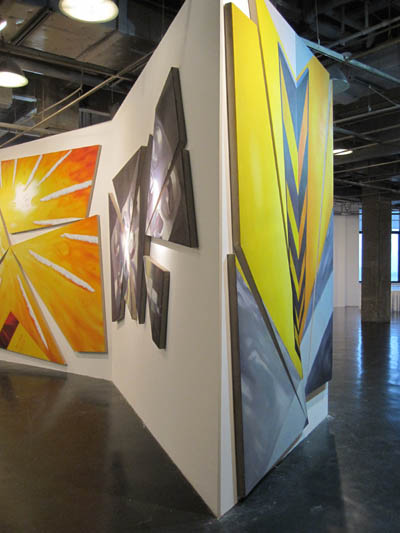CHEN WENBO: ABIO-VIEW
| February 1, 2010 | Post In LEAP 1

For the past ten years, Chen Wenbo has been painting scenes of isolated objects without people. The isolation comes from the relationship between restraint and erasure, lending Chen’s work an air of cold detachment. This indifference is pronounced in the lack of emotion in Chen’s flat vocabulary, but also the disconnect between the painted objects themselves and their relation to the outside world. There is nowhere for meaning to go, nothing to point the way for desire, and all that is left is the image itself.
Chen Wenbo’s show “Abio-View,” on view at the Shanghai Gallery of Art, is, as its name implies, utterly conceptual. Chen posits painting as a collection of activities, establishing dynamic relationships beyond the images—between name and substance, speaking and watching, representation and reality. These structural efforts stand in sharp contrast to the indifferent imagery of the works. Beginning in his 1994 piece Expressions in Fresh Meat, Chen attempted to explore the ontology of the image in a work reminiscent of Joseph Kosuth’s One and Three Chairs. After Expressions in Fresh Meat, the commercialized portraits of his “Vitamin” series functioned as signifiers commenting on consumer society and material culture. Later, conflicts between image and object, appearance and reappearance, surfaced repeatedly in Chen’s work, followed by the elimination of narrative and textuality from his painting vocabulary. Elevated highways, railway platforms, billiard tables, compact discs—these are only background. While people are missing, the objects that serve as the mediums for their relations of consumption are never absent.
In the exhibition, these mediums all live in a gorgeous light-filled world of representation. This world is interwoven with the landscape of the Bund outside its windows, like a massive screen spreading out in front of our eyes. There is no plot, no dialogue, only the images of objects and pure visual worship. Amid the light and shadow of this screen, we can see the image of a rising stock index, a mosaic of human bodies, drugs spread out on a table, a dart hitting its mark and an empty elevator interior. They are taken from photographs as ordinary as one could imagine, but their frames are calmly cut and ripped by the artist in a sober, restrained murdering of urban life. Proof of crime lies in the divided, misshapen canvases, making the reassembled paintings appear as if reflected in broken mirrors. And the grave, dazzling light? An uneasy night omen.
Why do the sensual pleasures of night in the city look so dismal? Chen Wenbo provides his audience with the crucial clue: “When this viewpoint is in motion, it documents an amnesiac reality. What is left behind is a file that uncovers urban lives, or a report of a follower, in between exposure or disclosure.”
Does viewing become a mere an inorganic operation? If the act of viewing is no longer the construction of a relationship between people and objects, then do things come to rest after the artist casts off the two-dimensional space of painting? The dismembered canvas carries the displaced image, and it resembles a damaged portion feeling the whole, like the present abandoning the past. Chen Wenbo both signifies and imbues things with meaning while at the same time surpassing them. Precisely such a disjointed visual state allows the viewer to escape the predicament of being dominated by the image, adapting to an alternate, disordered set of viewing relationships.
When Benjamin said we could cultivate a more distracted state of mind as a habit, he was pointing to a casual and hidden power to control. Chen Wenbo’s painting redirects vision by newly positioning its subjects into the deviances and crevices, trying to control a depression in the discourse of painting. The painter displays all kinds of artifice on the canvas in his dazzling, sober polyhedrons; in their scattered, confused anti-forms they create a new dialectic out of unbalanced visual perception—and might fall into another formalized visual trap. Azure Wu

